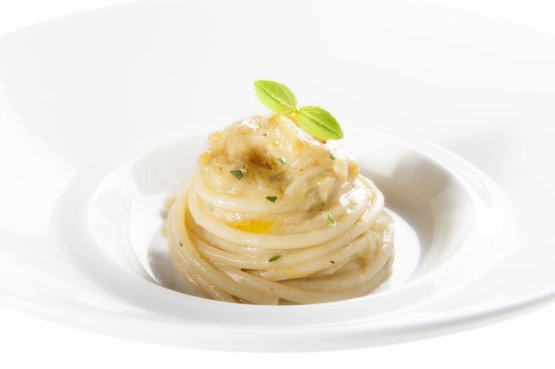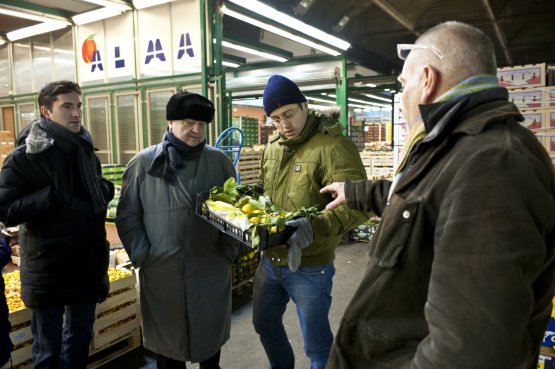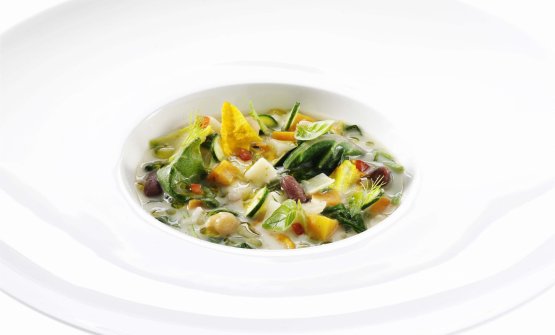“Like nobody else in the world, Aimo Moroni aimed to create a national cuisine” is written in the catalogue of Regine & Re di Cuochi, the show ending today at Stupinigi’s Castle. The book, written by Marco Bolasco, Elisia Menduni, Bob Noto, Nicola Perullo and Fabio Rizzari, is beautiful and perfectly portrays, in our case, the role the chef originally from Tuscany had in over 50 years of career.
In this article we presented his masterpiece: conveying a real idea of national cuisine, even more than a style, to a young generation – that of Alessandro Negrini and Fabio Pisani; a virtual heritage, a forma mentis: the extraordinary (and invincible) union of the great Italian culinary tradition with a contemporary taste. Let’s now analyse the heritage that was conveyed. Always in the words of Aimo and his daughter Stefania.

Spaghettoni al cipollotto, one of the most famous dishes by Aimo and Nadia. The first edition is from 1965
Stefania Moroni: «Today we give for granted that a dish made with onions can be as good as one made with expensive ingredients. However, in the Fifties and Sixties “fine dining” was French, rich in proteins, created for a client that would perhaps go to Paris to enjoy it. My father was the one to change this, together with few others, like Franco Colombani».
Aimo Moroni: «I don’t like the definition of “poor cuisine”, for the very reason that this poverty is what makes it rich. I’m in Italy, I can count on excellent raw materials. I go to the market, buy the best products and based on what I bring home I’ll make do and create a recipe. Never the opposite».
No excellence, no shopping, no recipe.
AM: «Indeed. For decades I used no oregano. It came from the large-scale retail trade. Then we spent 4 days in Pantelleria and saw this bright green oregano, dried by the sun and the wind: it doesn’t get black, it keeps its intense aroma. This is how it entered my kitchen».
SM: «One could say the same about everything else: from the oil from Sicily to Martini’s Piedmontese meat».
Extraordinary suppliers who have been working with you for decades…
SM: «…and today are our “accomplices”. An intense relationship has grown with them because each one knows he doesn’t work just for himself but represents a part of the system».
AM: «A special connection was born with many of them. I hadn’t been for four days at the Ortomercato and immediately the mother of the guys at Fruttasì prepared me a coffee, perhaps the worst in Milan, yet unforgettable: “T’ho minga vist, te ste ben?” [I haven’t seen you, are you ok?]. Or Michele Martini, an old butcher in Boves [born in 1926, today his son Roberto continues his work]: he writes me poems on A4 paper and then sends them to me. They speak of autumn, grapes, capon and so on».
SM: «Dad answers calling him on the phone: they end up speaking about fog for an hour».

Aimo at the Ortomercato in Milan with Pisani and Negrini
AM: «It must have the legs of a crocodile and the shape of a Concorde: tall, with a very thin head, not fat. That is the right capon».
SM: «All these stories have nourished a special team, this is why we cannot move from Via Montecuccoli. Over the years, there’s been magic growing here, and it cannot and must not be broken. It’s a sort of genius loci. Some clients have been coming for 30, 40 years. We cannot leave them because we would loose a rich memory, a network of relations on which these walls are founded. Fabio and Alessandro didn’t get this immediately, but they do now and are enriched by it».
A criticism to today’s dining?
AM: «First of all, a criticism to the shopping, which is an essential step. A lot is being said about cooking, but almost nothing about what and how to buy. You go to a shoe shop, try 20 pairs of shoes and then perhaps buy one; instead, you go to a butcher and hastily ask for: “three steaks, please”. It’s a mistake».
Let’s learn how to buy, then. But what’s wrong in the restaurant industry?
AM: «We’re the homeland of Mediterranean cuisine but perhaps we don’t valorise it enough. In Milan it’s easier to eat sushi than vermicelli alla pummarola. Instead, I’m proud I’ve promoted – and still do, through Fabio and Alessandro – the great and good Italian cuisine, without mental rigidity but with creativity. Moreover, I believe the future will be increasingly globalised, but 80% of the international clientele in Italy will want to taste our delicacies so we can never forget chicory and broad beans in Apulia or lampredotto in Florence. Then, let’s give a go ahead to creativity. Yet these dishes represent our culture and the Mediterranean diet is good to history, to the palate and to health».

The Zuppa Etrusca was born in 1980
AM: «No. However, when I read about young chefs defined as “innovative”, I think this is bad for them. It induces them to overdo it, and then they present cubes of fassona beef killed by a thousand different spices, covering the extraordinary and delicate flavour of the best meat in the world».
SM: «We’ve “trained” Alessandro and Fabio to manage their creativity without losing sight of the north star of taste. We introduced, every Monday, a special themed evening, through which they could go wild: they had complete freedom for 6 or 7 dishes of their own. Then we found the right wavelength».
Is there complete harmony now?
AM: «Yes, but I’m always keeping an eye on them [he smiles]. In the morning I go to the cellar, observe the refrigeration room, taste. The other day I suggested changing some tomatoes, because they were not good enough. But in general, there are no problems, also thanks to the fact that Stefania was extraordinary in holding the helm. Having her support, I could calmly make them understand my idea of cooking».
What’s the hardest thing to teach?
SM: «The hardest thing is also the most important: widening the horizons of taste perception; taste not only using your taste buds but your mind too. Sometimes, in order to do so you have to make a food less recognisable. There’s a beautiful novel titled Flatland: it portrays a world in mathematical and geometrical terms, the characters only having two dimensions. Its inhabitants could only understand what they saw, they had no other perception. See: those who come here for the first time, are like the inhabitants of Flatland, they only know two flavours. Letting them go beyond is Il Luogo’s mission: perceiving a more complex texture in the palate, removing salt, so as to better tell an aroma from the other...».
(2, the end. The first episode here)